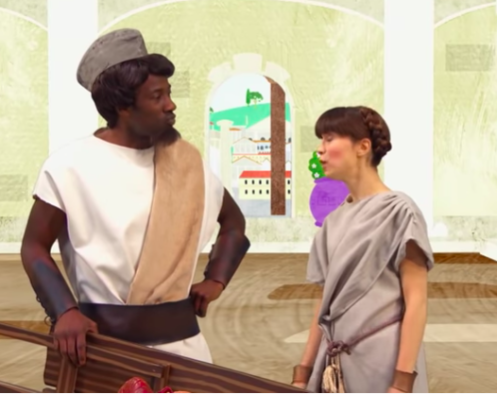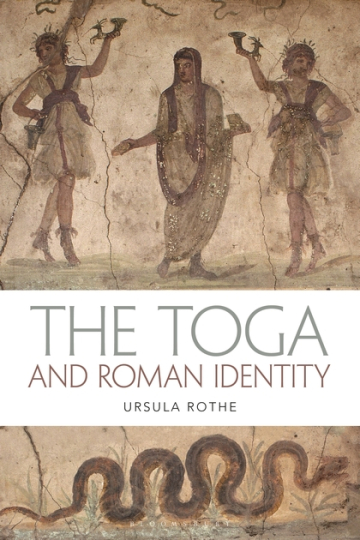Dr. Toga (original) (raw)
Doctor Toga

This page is a one-stop clinic for people looking for advice on Roman dress.
I am a UK-based scholar who has worked in the field for nearly 20 years and am trying to combat the misinformation available on the web about what the Romans wore.
If you are from
- a visual media organisation
- a reenactment society
- an amateur dramatic society
or you are just an interested person trying to find expert advice on Roman clothing, you’ve come to the right place. Consult the FAQs below or contact me via the email link at the bottom and I will do my best to treat your problem!
News
My Work
Public Outreach
I write blogs and articles for non-academic publications such as The Conversation, give public lectures and run Roman fashion shows for schools. Get in touch via the email link at the bottom if you would like me to present at your school or society. Click here to see an interview with me on Roman dress on Classics Confidential.

Consultancy
I have worked behind the scenes on a number of TV shows for companies including ZDF (Germany) and, most recently, the BBC. Get in touch via the the email link at the bottom if you are from a TV production company and would like advice on costumes for programmes with a Roman theme.

Academic Publications
I have written extensively on Roman dress in academic publications. For a selection see below. My most recent work is The Toga and Roman Identity, which is available from Bloomsbury Press.

FAQs
Did all Romans wear the toga?
No. In the very earliest period of Roman history, it was a more general garment used by both men and women. But in the period covered by most of our written sources and visual evidence – the late Republic and Empire – the toga was worn almost exclusively by free (i.e. not slave) men who held the legal status of Roman citizen. There are some very few exceptions to this: for children see below. The toga was a large and expensive garment that not everyone could afford, and not all men would have worn one on a daily basis. For class distinctions see below. Dress was worn according to weather and occasion: there were various kinds of hooded cloaks for outdoor wear and special outfits for banquets, for example. People in the countryside wore very different dress from people in the cities, and in the Roman provinces there was a wealth of different local dress styles that continued to be worn after Roman rule. In clothing terms, the Roman Empire was a very colourful place!
What did the toga look like?
The toga was a large, semi-circular piece of cloth made from wool that was usually off-white in colour. It was draped diagonally around the body in a variety of ways that changed over time. The basic draping style is shown below:

Did Roman men and women wear different clothing from each other?
Yes. In the very earliest period of Roman history, we have reason to believe that the toga was worn by both men and women. But in the period covered by most of our written sources and visual evidence – the late Republic and Empire – free citizen men wore a toga over a knee-length tunic and most women wore a rectangular cloak over a foot-length tunic. Married Roman women could also wear a special pinafore called a stola over their tunic. But not everyone could afford these garments, and there would have been many other clothing types visible on the streets of Rome at any given time.
Did Roman children wear different clothing from adults?
Freeborn children – both girls and boys – could wear a special type of toga with a purple stripe that signified protection until the came of age (boys) or married (girls). Usually, though, children wore smaller versions of adult garments like tunics and capes.
Was Roman clothing differentiated by social status?
Yes and no. There was very little in the way of strict dress codes for different social groups, although we do have reason to believe that the toga was supposed to be worn only by Roman citizens. Most people dressed according to their occupation: tunics and togas for politicians and wealthy businessmen, plain tunics for artisans doing manual work such as carpentry or pottery, and loincloths for the very hardest manual labour, such as mining. Slaves were not distinguished by their dress, and will have dressed according to the work they were involved in. Soldiers wore the clothing expected of them for the unit/activity they were engaged in (see below).
Did Romans wear underwear?
Probably not. Roman women wound a large band of cloth around their chests to give their breasts support, but otherwise the evidence we have suggests that people did not wear undergarments. The ‘briefs’ found in London and depicted in the Piazza Armerina mosaics were almost certainly designed to cover the private parts in the absence of actual clothes (much like modern bathing suits), for example for athletic activity.
Did the Roman army have a uniform?
Yes and no. The Roman army did not issue standardised garments with the expectation that members of units would look identical in their clothing, and it was usually up to soldiers to acquire the clothing they needed. But members of specific units did tend to wear similar garments to one another, and to reserve certain garments for specific contexts, such as combat, parades or fatigue activities. Much more uniformity can be found in the weaponry and armoury used by members of an army unit at any given time.
About Me

I am Senior Lecturer in Classical Studies at the Open University in the UK.
I specialise in Roman dress and what it tells us about Roman culture. All human cultures have dress, and I believe that understanding how it functions is one of the best ways of understanding a society’s fundamental character.
Selected publications
Books:
The Toga and Roman Identity, London 2019
Dress and Cultural Identity in the Rhine-Moselle Region of the Roman Empire, Oxford 2009
Journal articles and book chapters:
‘Veiling in the northern Roman provinces’ in: T. Ivleva et al. (eds), Embracing the Provinces, Oxford 2018, 93-100
‘Ethnicity’ in: M. Harlow (ed.), A Cultural History of Dress and Fashion 1: Antiquity, London 2017, 119-34
‘Whose fashion? Men, women and Roman culture as reflected in dress in the cities of the Roman north-west’ in: G. Woolf/E. Hemelrijk (eds), Women and the Roman City in the Latin West, Leiden 2013, 243-268
‘Die norisch-pannonische Tracht: gab es sie wirklich?’ in: G. Grabherr et al. (eds), Relations Abroad: Brooches and Other Elements of Dress, Innsbruck 2013, 33-48
The “Third Way”: Treveran women’s dress and the “Gallic Ensemble”’ in: American Journal of Archaeology 116 (2012), 235-252
‘Dress in the middle Danube provinces: the garments, their origins and their distribution’ in: Jahreshefte des Österreichischen Archäologischen Instituts 81 (2012), 137-231